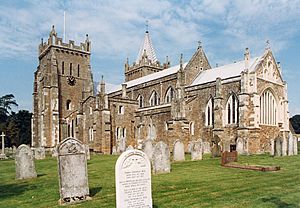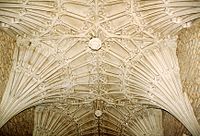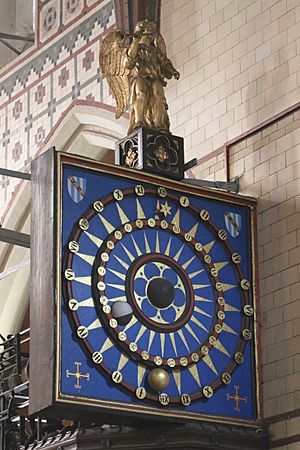St Mary's Church, Ottery St Mary facts for kids
Quick facts for kids St Mary's Church, Ottery St Mary |
|
|---|---|

St Mary's Church from the south east
|
|
| 50°45′11.04″N 3°16′44.03″W / 50.7530667°N 3.2788972°W | |
| Location | Ottery St Mary, Devon |
| Country | England |
| Denomination | Church of England |
| Churchmanship | Broad Church |
| History | |
| Dedication | St Mary the Virgin |
| Consecrated | 1260 |
| Architecture | |
| Heritage designation | Grade I listed |
| Specifications | |
| Length | 163 feet (50 m) |
| Height | 71 feet (22 m) |
| Administration | |
| Parish | Ottery St Mary |
| Deanery | Ottery |
| Archdeaconry | Exeter |
| Diocese | Diocese of Exeter |
| Province | Province of Canterbury |
St Mary's Church is a very old and important church in Ottery St Mary, Devon, England. It is a Grade I listed building, which means it's considered one of the most important historic buildings in the country. It is part of the Church of England.
This church also works with four other churches in the town as part of "Churches Together in Ottery St Mary."
Contents
History of St Mary's Church
St Mary's Church is sometimes called "a miniature Exeter Cathedral" because it has a similar shape. Both churches are built in a cross shape, with towers where the arms of the cross meet.
The church is about 163 feet (50 meters) long, and its towers are 71 feet (22 meters) high. It was officially opened and blessed in 1260. At that time, the church belonged to Rouen Cathedral in France. Experts believe that the tower-transepts (the towers that form the arms of the cross) and the outer walls of the main part of the church (the chancel) were built around 1260. The towers might have been built to look like those at Exeter Cathedral.
As a Grade I listed building, St Mary's is one of 107 important historic sites in the area. Records show it was blessed in 1260 by Bishop Bronescombe. Later, around 1330, Bishop Grandison made many changes and additions. The church is mostly built in the Early English style, which is a type of Gothic architecture. It has two towers above the transepts. The inside of the church was greatly repaired and updated in the mid-1800s by an architect named William Butterfield and others. During the 1300s, parts of the church were rebuilt, and a Lady Chapel was added at the east end. Two smaller chapels were also added on either side of the chancel. Around 1520, the north side of the nave (the main part of the church where people sit) was expanded. This new part has a beautiful, detailed ceiling with fan-shaped patterns and hanging decorations.
St Mary's College: A Special Church Foundation
In 1335, John Grandisson, who was the Bishop of Exeter, bought the church and its land from Rouen. On January 22, 1338, he started a special group called a "collegiate foundation" with forty members. This meant a group of clergy (church leaders) lived and worked together at the church.
Bishop Grandisson rebuilt much of the church. The main parts you see today, like the nave, chancel, aisles (side sections), and Lady Chapel, were built during his time. The nave has five sections, and the chancel, which is unusually long, has six sections, with small chapels on the north and south sides.
The church is famous for its painted roof and a special aisle from the early 1500s called the Dorset Aisle. This aisle has a unique fan-vaulted ceiling, which means the stone ceiling looks like a fan. It was designed and paid for by Cecily Bonville, 7th Baroness Harington.
Inside the church, there are ten "misericords" from 1350. These are small wooden ledges on the underside of folding seats in the choir, used for support when standing during long services. Five of them show the coat of arms of Bishop John de Grandisson. You can also find two medieval stone carvings of "green men," which are faces made of leaves. Other interesting things to see include the tombs of Otho de Grandisson and his wife, the altar screen, and a wooden eagle given by Bishop Grandisson.
The collegiate foundation was closed on December 24, 1545. After that, St Mary's became a regular parish church, serving the local community. The other buildings that belonged to the college were taken down.
St Mary's as a Parish Church
On May 21, 1849, the church was closed for a big restoration project led by architect William Butterfield. He made changes like lowering the floor in some areas to match the nave, making the church more suitable for a regular parish. All the old galleries (balconies) were removed, except for one in the south transept that was kept for the organ. The old pews were replaced with open seating. The area around the altar was paved with decorative tiles. The walls were cleaned and scraped of old plaster.
The church reopened on May 22, 1850. The restoration was paid for by donations from people who wanted to help, including a large gift of £1,200 from Mr. Justice Coleridge.
New choir stalls (special seats for the choir) were added in 1908. They were designed by John Duke Coleridge and paid for by Miss Mary Dickinson to remember her father, Rev. Frederick Binley Dickinson.
In 1934, three empty spaces in the old altar screen were filled with carved scenes. These sculptures were made from Beer stone by Herbert Read, an artist from Exeter. Mrs Winstanley paid for this work to remember her husband, Harold Winstanley.
There is a small stone plaque in the south churchyard wall that remembers the famous poet Samuel Taylor Coleridge. The church records for Ottery St Mary parish, which start in 1601, are kept in the Devon Record Office.
Sir Ernest Mason Satow, a scholar and diplomat who studied Japan, is buried in the churchyard. Inside the church, there is a plaque that honors his life. This plaque was originally in the British Legation chapel in Peking (now Beijing).
On September 26, 2015, St Mary's Church was the location of a special event. It was the first time in the Church of England that a woman, Sarah Mullally, who was the Bishop of Crediton, led a service to ordain (officially make) two deacons into priests.
Astronomical Clock
In the south transept (one of the tower sections), you can find the Ottery St Mary astronomical clock. This is one of the oldest working mechanical clocks in the country! Many people believe it was created by Bishop John de Grandisson, who was Bishop of Exeter from 1327 to 1369. The clock shows the Earth at the center of the Solar System, which was the common belief at that time.
The clock was repaired and made to work again in 1907.
Organ
St Mary's Church has had organs for a very long time, at least since the 1300s. Bishop Grandisson's rules for the collegiate church mention them. By the time the college closed in 1545, there were three organs. However, any organs that were still there in the 1600s were destroyed in 1645 during the English Civil War.
Around 1828, a company called Flight and Robson provided a new organ. This organ was moved to the south tower in 1849. Hele & Co did more work on the organ in 1878 and again in 1901. After more work in 1934, Eustace and Alldridge from Exeter made the organ bigger by adding pipes from other famous organ makers. The organ was rebuilt again in 1990 by Michael Farley. You can find more details about the organ on the National Pipe Organ Register.
Parish Status
St Mary's Church is part of a group of churches in a joint parish. This means they work together. The other churches in this group are:
- St John the Baptist's Church, Colaton Raleigh
- St James and St Anne's Church, Alfington
- St Gregory the Great's Church, Harpford
- St Luke's Church, Newton Poppleford
- St Edward the Confessor's Church, Wiggaton
- St Gregory's Church, Venn Ottery
- St Michael the Archangel's Church, West Hill
See also
 In Spanish: Iglesia de Santa María (Ottery St Mary) para niños
In Spanish: Iglesia de Santa María (Ottery St Mary) para niños



